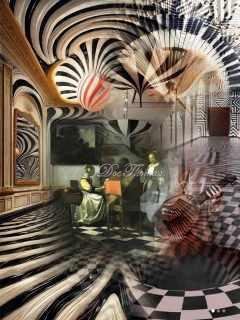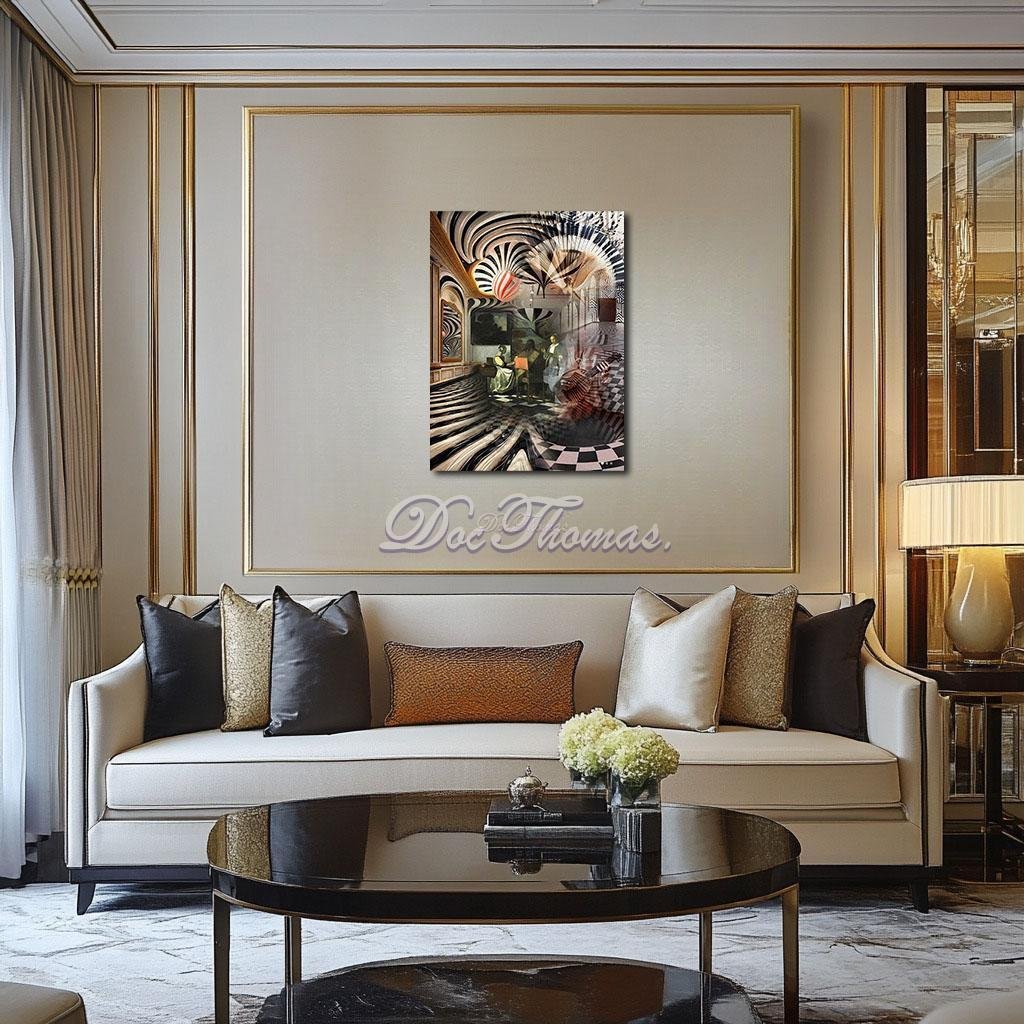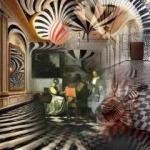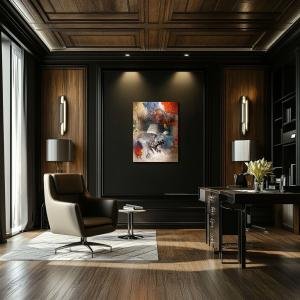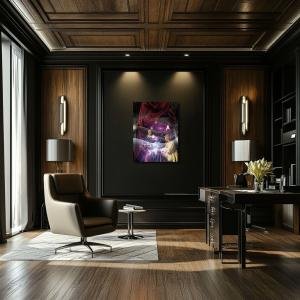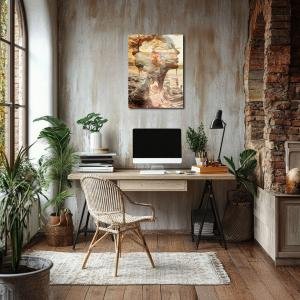Veins of Porcelain: Echoes Beneath the Marble Spiral
Veins of Porcelain: Echoes Beneath the Marble Spiral reimagines Vermeer’s The Concert as a hypnotic distortion of harmony and perception. The serene trio at the painting’s heart remains intact, but the chamber surrounding them collapses into a rippling black-and-white vortex, where sound becomes architecture and geometry is shaped by music. Striped spirals bend the space into hypnotic curves, while spectral figures and floating notes emerge like echoes from unseen dimensions. Red orbs and ghostly instruments pulse with emotion, contrasting against the monochrome illusion. This reinterpretation is a symphony of perception, a surreal homage to how melody bends time and space—where harmony becomes motion, and silence hums beneath every ripple.
Please see Below for Details…
Hotline Order:
Mon - Fri: 07AM - 06PM
404-872-4663
Veins of Porcelain: Echoes Beneath the Marble Spiral is a surreal reimagining of Johannes Vermeer’s The Concert , where the quiet civility of domestic music-making dissolves into a vertiginous dreamscape of distortion, optical echo, and melodic geometry. Here, the chamber of art and harmony warps under the pressure of memory, perception, and time. No longer a simple trio—man, harpsichord, and lute—this is now a vortex of sound and identity, spiraling into a black-and-white maelstrom of introspection and illusion. Vermeer’s elegance meets surreal futurism, and from this improbable duet arises a visual symphony of dissonant reverie.
The original composition, serene in its arrangement and luminous in Vermeer’s palette, is left intact at the center—two women and a man engaged in music, bathed in warm daylight, poised within the disciplined framework of Dutch interiors. But in this reinterpretation, that poised harmony becomes the eye of a surreal storm. The architecture surrounding the figures contorts, becoming a ribbon of black and white stripes that pulsate across the floors, walls, and ceilings like rippling soundwaves, or the coiling grooves of a vinyl record. Music is no longer just heard—it is felt, seen, disoriented, and stretched into the architecture itself.
As the artist, I approached this reimagination with the question: what does harmony look like when consciousness bends around it? The figures remain calm, but the world they inhabit swells with movement, as if the act of playing has ruptured the very foundation of reality. The swirling distortions are not chaotic for chaos’ sake—they are the metaphysical manifestation of vibration, tone, and perception. What if music warped space as much as it soothed the soul?
Color becomes the language of mood and tempo in this vision. The black and white bands dominate, referencing both classical formality and emotional extremity. These tones are not neutral—they are aggressive, infinite, hypnotic. They ripple across the frame like concentric waves in a pool disturbed by sound. In contrast, bursts of red—seen in the floating orb and the ghostly lute—act as pulses of passion, heat, and awakening. The red is the tremble beneath the skin, the blushed flush of performance, or the tension of repressed desire. It punctuates the monochrome with urgency and life.
Golden tones on the left side of the frame preserve some of Vermeer’s original glow, reminding us of the room’s domestic source. Yet even these warm golds now reflect something alien, like light refracted through a hall of mirrors. The mirror itself is echoed in the curvature of the walls, where dimensions bend like a funhouse, offering no clear vanishing point. This bending signifies how the familiar becomes unfamiliar in the presence of beauty, memory, or loss. A mirror does not only reflect—it distorts, it selects, and it remembers falsely.
To the right, another ghostly figure emerges—semi-transparent, haloed in fan-like arcs, a musician perhaps, or a muse, hovering above the concert with ambiguous intent. Her presence suggests either a future self or a memory, drifting across time to hover above the present. Her limbs are fragmented, dissolving into the geometry of space. She doesn’t watch the performance; she becomes part of its rhythm. This blending of body and space was intentional—music is not just played, it inhabits. Her colors—soft whites and ghostly greys—contrast against the heavy blacks and reds, creating a tonal fugue in visual form.
Floating across the entire scene are slices of musical notations—subtle, spectral. They aren’t legible, but they are felt. They form a language without grammar, a syntax of echo and breath. Their appearance across clothing, walls, and air shows how melody travels, sticking to surface and self alike. Even the tiled floor seems to vibrate with these sounds, its checkerboard pattern no longer flat, but swelling, breathing, like the diaphragm of a cello.
Vermeer’s original intimacy remains central, but is no longer the endpoint—it is the still core from which this storm of illusion explodes. The music in the room might be light, but the world around it becomes epic. That tension is the soul of this reinterpretation.
The conceptual aim of this piece was to explore sound as distortion. Not distortion as destruction, but as expansion—how beauty warps reality, how harmony doesn’t contain but rather spreads, echoing across time, memory, and the unconscious. In The Concert , music is a shared act. Here, it becomes a dimensional shift. One woman plays, another listens, and the man provides harmony. But around them, past and future selves unspool, space bends, and time folds inward. They are no longer just musicians. They are conjurers of spiral and shape, composers of atmosphere, dreamers inside sound.
Add your review
Your email address will not be published. Required fields are marked *
Please login to write review!
Looks like there are no reviews yet.

